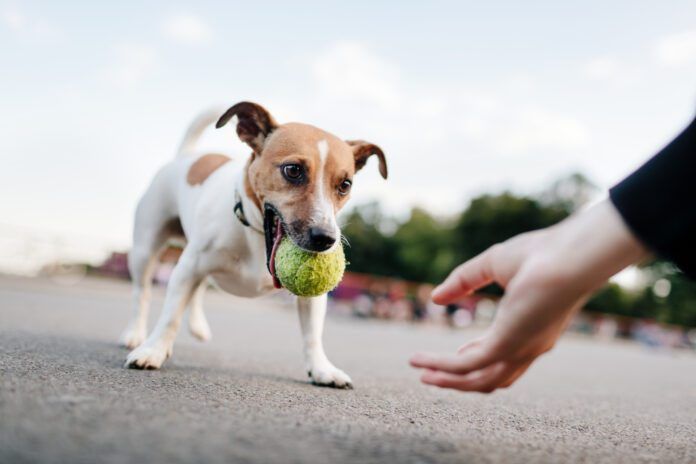
Any breed of dog can be taught to fetch an item, but some dogs, primarily those with “retriever” in their names usually come a bit more hardwired toward the tendency to chase an object and bring it at least part of the way back to the handler.
For many dogs, the following tips will help teach the game of fetch:
- Use an object your dog wants and pique his interest before throwing.
Just because we think something makes a great fetch toy doesn’t mean your dog agrees and will join in the game. Using a favorite object makes it more likely your dog will want to go get it. For some dogs, that might be a favorite toy. For others, it might be an empty water bottle.
Before throwing the object, get your dog interested. Tease him a little bit. “You want it? Can’t get it!” as you wiggle the toy his direction and then make it skitter away as if it’s a small prey animal. Observe your dog’s reaction; it’s easy to overdo it, and if you come on too strong, your dog may disengage.
When your dog is showing excited interest in the object, give it a toss.
- Keep your throws short in the beginning.
Avoid throwing the toy across the yard or even across the room to start. A toss of 6 to 10 feet is perfect. Once your dog understands and is excited about the game, you can make your throws longer.
- Back away as your dog returns.
If your dog runs out and picks up the toy, offer praise as you back away and encourage your dog to come toward you. Avoid standing still, as that can create social pressure as your dog returns and sees you standing there like a wall. Backing away as you pat your legs and acknowledge your dog’s brilliance can encourage her to keep moving in your direction.
- Maintain excitement about the fetch item.
Some dogs will chase the toy as it moves but lose interest once it lands. If your dog runs out to the toy but doesn’t pick it up, run out and snatch it up yourself! Celebrate with the toy and treat it like a special prize. Your attention to the toy can help increase its value and make it more likely your dog will show more interest on the next throw. Tease your dog with the toy and, when he seems especially interested, try another short toss.
Mistakes to avoid
One of the fastest ways to teach a dog to play keep away with the toy rather than return to you is to immediately snatch and re-throw the toy as soon as he returns. Your dog did all the work in running out and coming back with the toy, he should be able to enjoy the fruits of his labor for a bit. When your dog returns with the toy, offer calm praise and petting without so much as thinking about reaching for the toy for 15 to 30 seconds. Make sure you’re petting your dog in a way he enjoys – you’ll know you’re getting it right because he sticks around. If he releases the toy on his own, you can pick it up and toss it again. Otherwise, wait the full 15 to 30 seconds before asking him to release the toy and preparing for the next throw. Alternatively, offer to “trade” him a treat for the fetch item.
Quit while you’re ahead
Ending the game before your dog loses interest will strengthen your fetch game. Try to avoid the “just one more throw” syndrome, especially when your dog is getting tired. Leave him wanting more.
Excessive fetch can do more harm than good and can turn fetch into an obsession that makes it difficult for your dog to relax. That’s because of the hormones released in the brain during the chase. A prolonged adrenaline rush isn’t good for any living being. It’s also important to prevent injury when playing fetch. Torn ligaments are especially common among fetch-obsessed dogs.
Shaping a more formal retrieve
Some people prefer to teach “fetch” as a more formal behavior that can be used in dog sports or service dog work. Denise Fenzi, founder of Fenzi Dog Sports Academy, offers a great blog post where she explains her approach to teaching a structured retrieve and includes unedited videos documenting the process with a client’s Border Collie.





